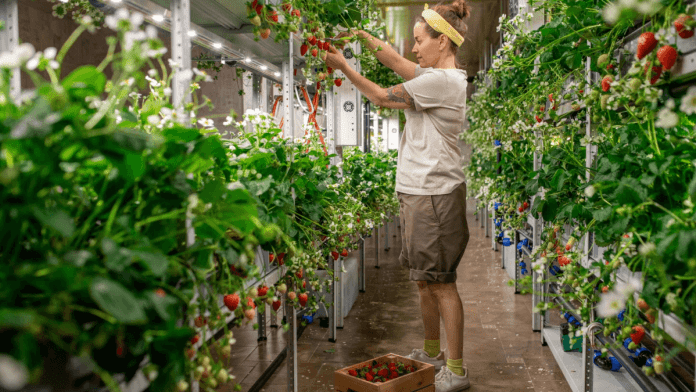News in Brief:
– Vertical farming offers hope amid global agricultural challenges, leveraging advanced tech for sustainable, space-efficient crop cultivation.
– Market projected to soar to $30 billion by 2031 as drive to reducing reliance on traditional farming methods vulnerable to climate change increases.
Farmable lands are dwindling due to the world’s population surge as well as other factors like deforestation. Sustainable farming practices are becoming more important than ever. Vertical farming, which involves growing crops in stacked layers within controlled environments, represents a revolutionary approach to agriculture.
Central to the success of vertical farming are advanced technologies such as robotics, artificial intelligence (AI) and the Internet of Things (IoT). These innovations empower farmers to meticulously manage factors like temperature and humidity, optimising crop growth and resource efficiency. This not only boosts yields but also conserves water and minimises land use —a game-changer for densely populated urban areas and regions facing environmental pressures.
According to a report titled ‘Vertical Farming Market Size, Share, Growth Drivers and Regional Analysis, Global Forecast 2024 – 2031’, the vertical farming market is projected to skyrocket from USD 6.87 Billion in 2023 to USD 30.0 Billion by 2031, with a robust compound annual growth rate (CAGR) of 20.23%.
This rapid expansion is driven by pioneers like Agrilution GmbH and Aerofarm, who are spearheading technological advancements and forging strategic alliances to scale sustainable farming solutions globally.
Beyond economic metrics, vertical farming addresses critical global challenges such as food security and environmental sustainability. By reducing reliance on traditional farming methods vulnerable to climate change and land scarcity, vertical farms offer a resilient alternative. This is particularly pertinent amidst geopolitical tensions, exemplified by disruptions in global supply chains due to conflicts like the Russia-Ukraine war.
Regional perspectives & opportunities
In North America, the United States is in charge of its robust infrastructure and supportive regulatory environment. Meanwhile, the Asia Pacific region stands poised for significant growth. Countries like Nigeria, grappling with rapid urbanisation and fluctuating agricultural productivity, can benefit immensely from vertical farming’s space-efficient and water-saving techniques.
Vertical farming isn’t just a technological marvel; it embodies a sustainable future for agriculture worldwide. As technological advancements continue to enhance efficiency and scalability, this innovative approach promises to secure food production while safeguarding our planet’s resources. For Nigerian farmers and global counterparts alike, embracing vertical farming signifies not only economic opportunity but also resilience in the face of evolving agricultural landscapes.



